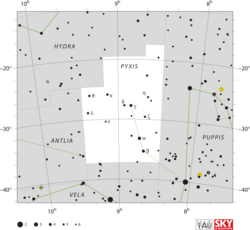Astronomy:Beta Pyxidis
| Observation data Equinox J2000.0]] (ICRS) | |
|---|---|
| Constellation | Pyxis |
| Right ascension | 08h 40m 06.14363s[1] |
| Declination | –35° 18′ 30.0″[1] |
| Apparent magnitude (V) | 3.954[2] |
| Characteristics | |
| Spectral type | G7II/III[3] |
| U−B color index | +0.646[2] |
| B−V color index | +0.935[2] |
| Astrometry | |
| Radial velocity (Rv) | –13.4[4] km/s |
| Proper motion (μ) | RA: +9.84[1] mas/yr Dec.: –20.80[1] mas/yr |
| Parallax (π) | 7.84 ± 0.19[1] mas |
| Distance | 420 ± 10 ly (128 ± 3 pc) |
| Absolute magnitude (MV) | –0.78[5] |
| Details[6] | |
| Mass | 1.2±0.3 M☉ |
| Radius | 24±2 R☉ |
| Luminosity | 324±15 L☉ |
| Surface gravity (log g) | 1.75±0.09 cgs |
| Temperature | 5,124±125 K |
| Metallicity [Fe/H] | 0.25 dex |
| Rotational velocity (v sin i) | 11.8[7] km/s |
| Other designations | |
| Database references | |
| SIMBAD | data |
Beta Pyxidis, Latinized from β Pyxidis, is a double star[8] located in the southern constellation Pyxis. It has an apparent visual magnitude of 3.954, making it the second brightest star in that faint constellation. Based upon parallax measurements, the star is an estimated 420 light-years (128 parsecs) from the Earth.[1]
The spectrum matches a bright giant or giant star of stellar classification G7II-III.G7II/III[3] It has 1.2 times the mass of the Sun but has expanded to 24 times the Sun's radius. The effective temperature of the star's outer envelope is about 5,124 K,[6] giving it the characteristic yellow hue of a G-type star.[9] Beta Pyxidis has an unusually high rate of spin for an evolved star of this type, showing a projected rotational velocity of 11.8 km/s. One possible explanation is that it may have engulfed a nearby giant planet, such as a hot Jupiter.[7]
In 2010, the star was among a survey of massive, lower effective temperature supergiants in an attempt to detect a magnetic field. This star may have a longitudinal magnetic field with a strength of less than a Gauss.[10] It is a young disk star system with space velocity components, [U, V, W] = [–11.0, +11.8, –2.2] km/s.[5] There is a magnitude 12.5 optical companion, located at an angular separation of 12.7 arcseconds and a position angle of 118° as of the year 1943.[11]
Naming
In Chinese, 天狗 (Tiān Gǒu), meaning Celestial Dog, refers to an asterism consisting of β Pyxidis, e Velorum, f Velorum, α Pyxidis, γ Pyxidis and δ Pyxidis. Consequently, β Pyxidis itself is known as 天狗四 (Tiān Gǒu sì, English: the Fourth Star of Celestial Dog.)[12]
References
- ↑ 1.0 1.1 1.2 1.3 1.4 1.5 van Leeuwen, F. (November 2007). "Validation of the new Hipparcos reduction". Astronomy and Astrophysics 474 (2): 653–664. doi:10.1051/0004-6361:20078357. Bibcode: 2007A&A...474..653V.
- ↑ 2.0 2.1 2.2 Gutierrez-Moreno, Adelina et al. (1966). "A System of photometric standards". Publications of the Department of Astronomy University of Chile (Publicaciones Universidad de Chile, Department de Astronomy) 1: 1–17. Bibcode: 1966PDAUC...1....1G.
- ↑ 3.0 3.1 Houk, Nancy (1979), Michigan catalogue of two-dimensional spectral types for the HD stars, 3, Ann Arbor, Michigan: Dept. of Astronomy, University of Michigan, Bibcode: 1982mcts.book.....H.
- ↑ Evans, D. S. (June 20–24, 1966). "The Revision of the General Catalogue of Radial Velocities". University of Toronto: Dordrecht, D. Reidel Publishing Co.. Bibcode: 1967IAUS...30...57E.
- ↑ 5.0 5.1 Eggen, O. J. (1994). "Photometry of F-K type bright giants and supergiants. 3: The luminosity, reddening, and heavy element abundance of GK stars". The Astrophysical Journal 107 (6): 2184–2210, 2205. doi:10.1086/117030. Bibcode: 1994AJ....107.2184E.
- ↑ 6.0 6.1 Kallinger, T. et al. (April 2019). "Stellar masses from granulation and oscillations of 23 bright red giants observed by BRITE-Constellation". Astronomy & Astrophysics 624: 17. doi:10.1051/0004-6361/201834514. A35. Bibcode: 2019A&A...624A..35K.
- ↑ 7.0 7.1 Rodrigues da Silva, R. et al. (March 2015). "On the Nature of Rapidly Rotating Single Evolved Stars". The Astrophysical Journal 801 (1): 6. doi:10.1088/0004-637X/801/1/54. 54. Bibcode: 2015ApJ...801...54R.
- ↑ 8.0 8.1 "bet Pyx". SIMBAD. Centre de données astronomiques de Strasbourg. http://simbad.u-strasbg.fr/simbad/sim-basic?Ident=bet+Pyx.
- ↑ "The Colour of Stars", Australia Telescope, Outreach and Education (Commonwealth Scientific and Industrial Research Organisation), December 21, 2004, http://outreach.atnf.csiro.au/education/senior/astrophysics/photometry_colour.html, retrieved 2012-01-16
- ↑ Grunhut, J. H. et al. (November 2010), "Systematic detection of magnetic fields in massive, late-type supergiants", Monthly Notices of the Royal Astronomical Society 408 (4): 2290–2297, doi:10.1111/j.1365-2966.2010.17275.x, Bibcode: 2010MNRAS.408.2290G
- ↑ Worley, C. E.; Douglas, G. G. (November 1997), "The Washington double star catalogue (WDS, 1996.0)", Astronomy & Astrophysics Supplement Series 125 (3): 523, doi:10.1051/aas:1997239, Bibcode: 1997A&AS..125..523W
- ↑ (in Chinese) AEEA (Activities of Exhibition and Education in Astronomy) 天文教育資訊網 2006 年 7 月 17 日
 |


